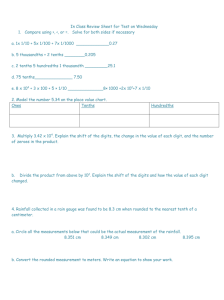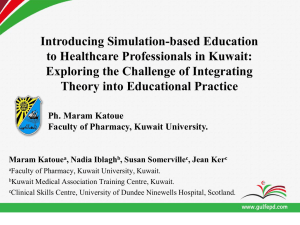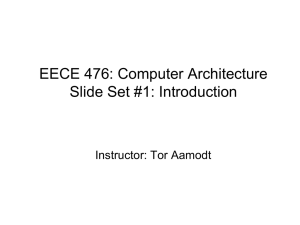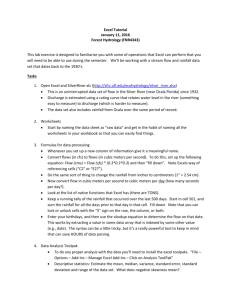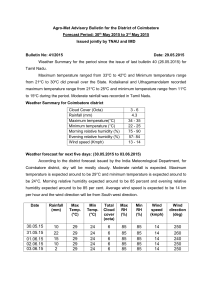Engineering Enhancement Template
advertisement
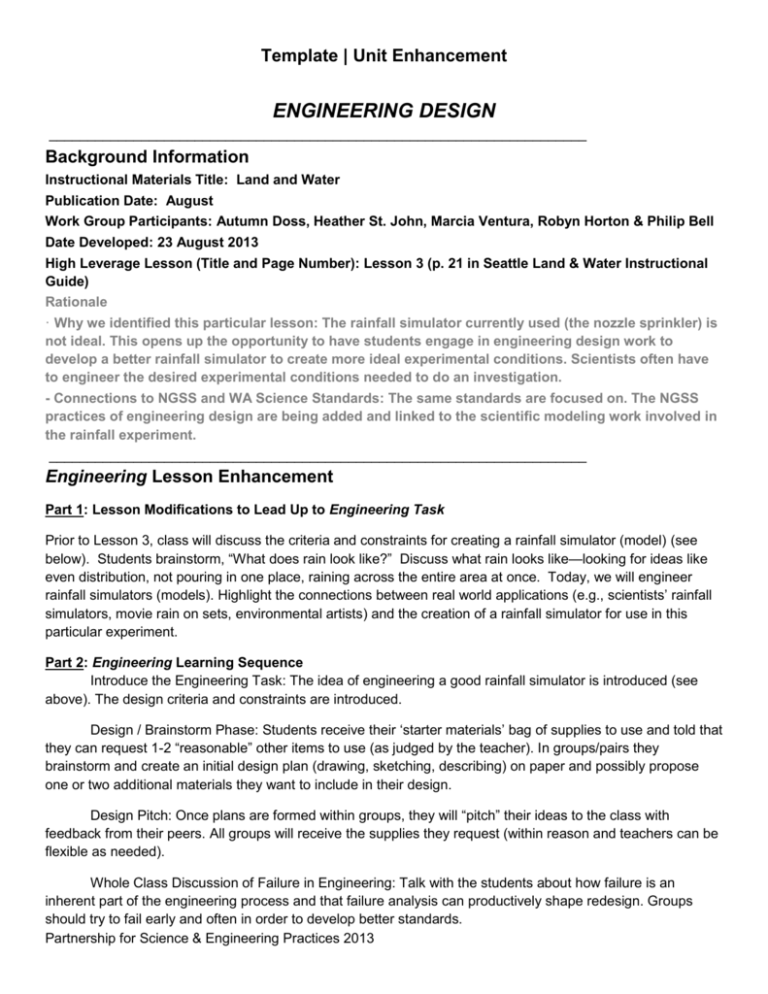
Template | Unit Enhancement ENGINEERING DESIGN ______________________________________________________________________ Background Information Instructional Materials Title: Land and Water Publication Date: August Work Group Participants: Autumn Doss, Heather St. John, Marcia Ventura, Robyn Horton & Philip Bell Date Developed: 23 August 2013 High Leverage Lesson (Title and Page Number): Lesson 3 (p. 21 in Seattle Land & Water Instructional Guide) Rationale · Why we identified this particular lesson: The rainfall simulator currently used (the nozzle sprinkler) is not ideal. This opens up the opportunity to have students engage in engineering design work to develop a better rainfall simulator to create more ideal experimental conditions. Scientists often have to engineer the desired experimental conditions needed to do an investigation. - Connections to NGSS and WA Science Standards: The same standards are focused on. The NGSS practices of engineering design are being added and linked to the scientific modeling work involved in the rainfall experiment. ______________________________________________________________________ Engineering Lesson Enhancement Part 1: Lesson Modifications to Lead Up to Engineering Task Prior to Lesson 3, class will discuss the criteria and constraints for creating a rainfall simulator (model) (see below). Students brainstorm, “What does rain look like?” Discuss what rain looks like—looking for ideas like even distribution, not pouring in one place, raining across the entire area at once. Today, we will engineer rainfall simulators (models). Highlight the connections between real world applications (e.g., scientists’ rainfall simulators, movie rain on sets, environmental artists) and the creation of a rainfall simulator for use in this particular experiment. Part 2: Engineering Learning Sequence Introduce the Engineering Task: The idea of engineering a good rainfall simulator is introduced (see above). The design criteria and constraints are introduced. Design / Brainstorm Phase: Students receive their ‘starter materials’ bag of supplies to use and told that they can request 1-2 “reasonable” other items to use (as judged by the teacher). In groups/pairs they brainstorm and create an initial design plan (drawing, sketching, describing) on paper and possibly propose one or two additional materials they want to include in their design. Design Pitch: Once plans are formed within groups, they will “pitch” their ideas to the class with feedback from their peers. All groups will receive the supplies they request (within reason and teachers can be flexible as needed). Whole Class Discussion of Failure in Engineering: Talk with the students about how failure is an inherent part of the engineering process and that failure analysis can productively shape redesign. Groups should try to fail early and often in order to develop better standards. Partnership for Science & Engineering Practices 2013 Development Phase 1: Students work in groups to create their initial designs and practice their rainfall simulators on the lid of their box with a paper towel covering (this protects the land until we are ready to perform the experiment). Gallery Walk (Revision/Optimizing): Students walk around the room and view different groups’ designs. This could be done with one-half of the group at a time so that half the room is roaming and the other half is showcasing and describing their designs. They then switch roles and do it again. The gallery walk is so students can change their designs and ideas if they find a more effective strategy. Development Phase 2: Students continue to think through their design and optimize / revise their rainfall simulator as necessary. Do the Experiment in a Fishbowl: Student groups explain their design and how it fits the design criteria. They then continue with the original work of Lesson 3, simulate rain using a fishbowl demonstration format with the actual land models. The whole class observes each groups’ functional design. They judge the quality of the rainfall produced and examine the effects on the land. Design Review: Engage the class in a short discussion about the rainfall simulators that were developed and what they learned about the design process—looking for things about working through failure, how the group process went, how the engineering work helped them create the right conditions for their science experiment. Part 3-A: Engineering Task Scientists, environmental artists, and film production companies all need to create rainfall simulators to do their work. The students in this lesson need a good rainfall simulator to engage in their science experiment about where rain goes (in Lesson 3). At the start of Lesson 3, student groups will design and create different rainfall simulators using materials provided to them and some reasonable items they request to use. They will test their rainfall simulators, iterate on their designs as needed, and use their simulators to perform experiment 3 (as described in the learning sequence above). The following table lays out the specific design criteria (requirements) and the specific design constraints (materials) involved in the engineering design task. Design Criteria All the soil should be hit evenly Rain to come down in drops (no mist or waterfalls) Use all 500 mL of water Design Constraints Starter Bag: Roll of Masking Tape 10 toothpicks Yard of saran wrap 3 cups (one of each kind, no damaging) 1 spoon 10 popsicles sticks (no damaging) 1 foot of foil 2 straws (can be altered) 2 ziploc bags 2 Liter Bottle and Bucket Students can propose one or two additional needed items in classroom dependent on teacher approval. *Students can choose the materials they Partnership for Science & Engineering Practices 2013 would like to use. They are not required to use everything. Part 3-B: Assessment Rubric Engineering a Rainfall Simulator Rubric Restate the design problem Students understand the criteria and constraints and can explain what they need to design Present an Initial Design Plan Students explain/list/draw their first ideas, why they rejected them, and their design plan Build and Test the Initial Design Students build and try out their design Refine and Optimize Students adapt or change their design based on the design criteria or other sources Partnership for Science & Engineering Practices 2013 Yes! Students fully describe the design problem Plan includes a clear design for the simulator using only the approved materials Students develop their rainfall simulator and successfully test and analyze its operation. They work through failure. Students take in feedback from the gallery walk Almost there . . . Students partially describe the criteria and constraints The plan is somewhat clear or somewhat complete Not yet Students don’t show an understanding of the design task The plan is not clear or complete Students complete the development of their simulator but fail to test is appropriately Students are not able to complete their simulator Students take in feedback from the gallery walk or Students do not take up feedback from the gallery Justify Final Design Students explain why their design meets the criteria Participation and Collaboration Students will work together and contribute throughout all phases of the engineering task and initial trial and revise their simulator successfully Students communicate the elements of their designs and how it fits with the design criteria Students collaborated as a team throughout the entire process their initial trial but fail to revise their simulator Students partially communicate the elements of their designs and how it fits with the design criteria Students were collaborating on specific portions of the process ______________________________________________________________________ Additional Information NOTES · Information that will be useful when teaching this lesson - Resources that will be useful - Scaffolds that students will use Partnership for Science & Engineering Practices 2013 walk or their trial Students are not able to communicate their design and how it has been developed to fit with the criteria Students did not collaborate successfully throughout the process



